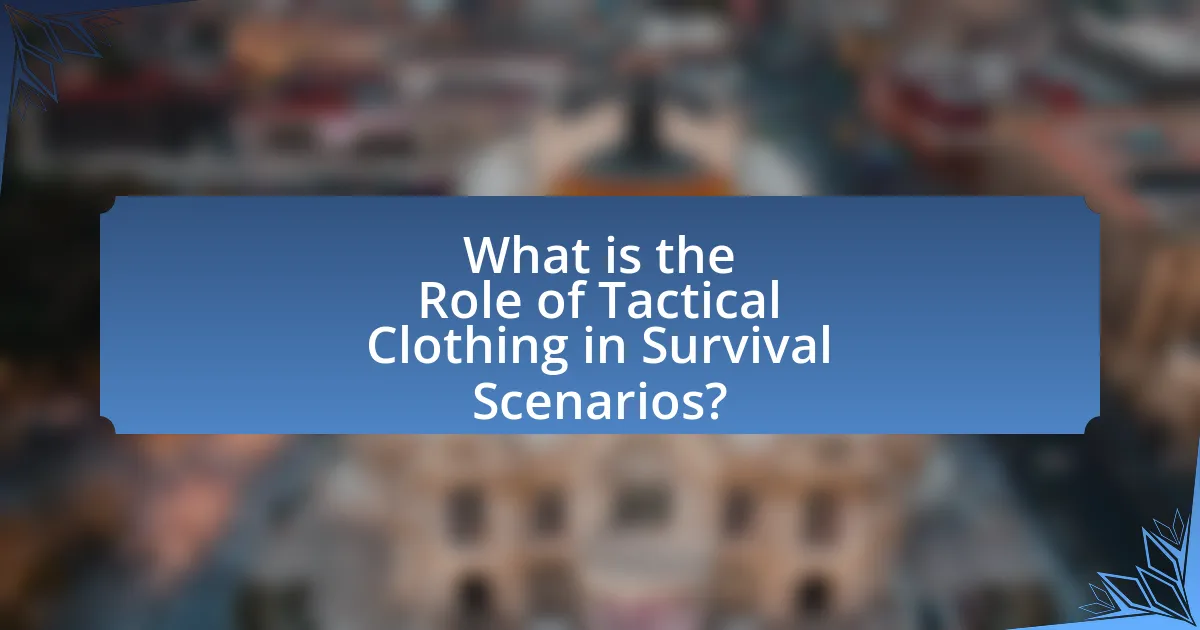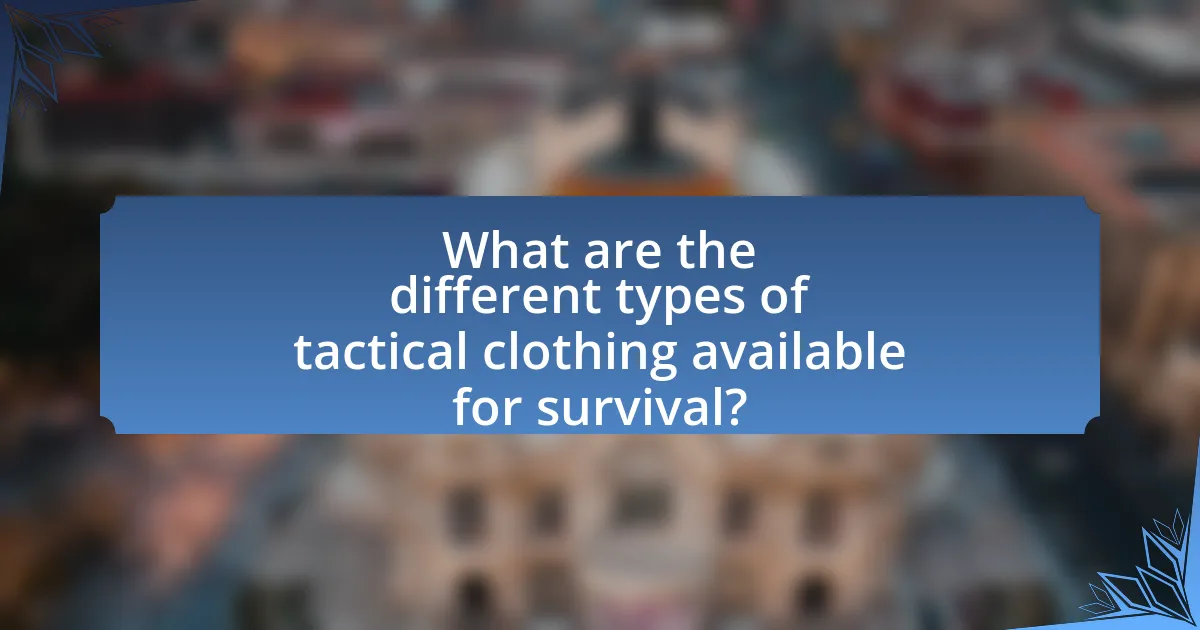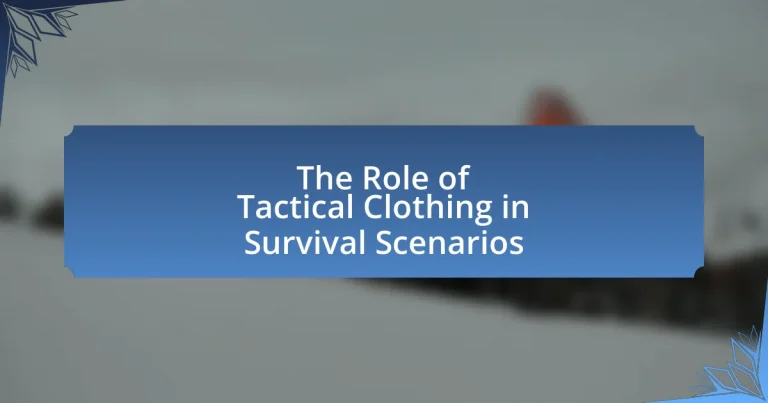Tactical clothing is essential in survival scenarios due to its durability, functionality, and protective features. Designed to withstand harsh conditions, these garments often include water resistance, breathability, and abrasion resistance, making them suitable for outdoor survival. Key features such as reinforced knees, multiple pockets, and camouflage capabilities enhance mobility and accessibility, which are critical in emergencies. The article explores the various types of tactical clothing, their specific roles in different survival situations, and best practices for selection and maintenance, emphasizing the importance of appropriate clothing in enhancing survival outcomes.

What is the Role of Tactical Clothing in Survival Scenarios?
Tactical clothing plays a crucial role in survival scenarios by providing durability, functionality, and protection. These garments are designed to withstand harsh conditions, offering features such as water resistance, breathability, and abrasion resistance, which are essential for outdoor survival. For instance, tactical pants often include reinforced knees and multiple pockets for carrying essential gear, enhancing mobility and accessibility. Additionally, tactical clothing is typically made from materials that offer camouflage, helping individuals blend into their environment, which can be vital for safety and stealth. The effectiveness of tactical clothing in survival situations is supported by its widespread use among military and law enforcement personnel, who rely on these garments for their resilience and practicality in demanding environments.
How does tactical clothing enhance survival capabilities?
Tactical clothing enhances survival capabilities by providing durability, functionality, and protection in challenging environments. The materials used in tactical clothing are often resistant to abrasions, tears, and weather elements, which ensures that individuals remain safe and comfortable during outdoor activities or emergencies. For instance, many tactical garments incorporate moisture-wicking fabrics that help regulate body temperature and keep the wearer dry, which is crucial for maintaining stamina and focus in survival situations. Additionally, tactical clothing typically features multiple pockets and attachment points, allowing for easy access to essential gear and tools, thereby improving efficiency in critical moments. The design of tactical clothing often includes camouflage patterns that help individuals blend into their surroundings, reducing visibility to potential threats. Overall, the combination of these features significantly increases the likelihood of survival in adverse conditions.
What are the key features of tactical clothing that aid in survival?
Tactical clothing designed for survival incorporates features such as durability, weather resistance, and functionality. Durability ensures that the clothing can withstand harsh environments and physical wear, often utilizing materials like ripstop nylon or reinforced stitching. Weather resistance is crucial, as it protects the wearer from elements such as rain, wind, and extreme temperatures, often achieved through waterproof or breathable fabrics. Additionally, functionality is enhanced through multiple pockets and attachment points, allowing for easy access to essential gear and tools. These features collectively enhance the wearer’s ability to navigate and survive in challenging situations, as evidenced by military and outdoor survival training programs that emphasize the importance of appropriate clothing in survival scenarios.
How do materials used in tactical clothing contribute to survival?
Materials used in tactical clothing enhance survival by providing durability, protection, and functionality in extreme conditions. Fabrics such as ripstop nylon and polyester are designed to resist tearing and abrasion, ensuring that clothing remains intact during rugged activities. Additionally, moisture-wicking materials help regulate body temperature and keep the wearer dry, which is crucial for maintaining stamina and preventing hypothermia in cold environments. Furthermore, tactical clothing often incorporates features like reinforced seams and pockets for carrying essential gear, which increases the wearer’s preparedness in survival situations. These attributes collectively contribute to a tactical advantage, enabling individuals to navigate and endure challenging scenarios effectively.
Why is tactical clothing important in various survival situations?
Tactical clothing is important in various survival situations because it enhances protection, mobility, and functionality. This type of clothing is designed with durable materials that resist wear and tear, providing essential protection against environmental hazards such as extreme weather, sharp objects, and potential injuries. For instance, many tactical garments feature water-resistant fabrics and reinforced stitching, which help maintain the wearer’s comfort and safety in challenging conditions. Additionally, tactical clothing often includes multiple pockets and attachment points for gear, allowing individuals to carry essential tools and supplies efficiently. This functionality is crucial in survival scenarios where quick access to equipment can be life-saving. Studies have shown that appropriate clothing can significantly impact an individual’s ability to perform tasks effectively in survival situations, underscoring the importance of tactical clothing in enhancing overall survival outcomes.
What types of survival scenarios benefit from tactical clothing?
Tactical clothing benefits survival scenarios such as military operations, outdoor adventures, emergency preparedness, and law enforcement activities. In military operations, tactical clothing provides durability and functionality, essential for combat situations. Outdoor adventures, like hiking or camping, require clothing that offers protection from the elements and enhances mobility. Emergency preparedness scenarios, such as natural disasters, benefit from tactical clothing’s resilience and utility features, allowing individuals to navigate challenging environments effectively. Law enforcement activities necessitate tactical clothing for its practicality and ability to support various operational needs, ensuring officers can perform their duties safely and efficiently.
How does tactical clothing provide protection against environmental hazards?
Tactical clothing provides protection against environmental hazards through specialized materials and design features that enhance durability, insulation, and resistance to elements. For instance, many tactical garments are made from water-resistant or waterproof fabrics, which prevent moisture penetration during rain or wet conditions. Additionally, tactical clothing often incorporates UV protection to shield the skin from harmful sun exposure, and thermal insulation to maintain body heat in cold environments. These features are critical for individuals operating in extreme conditions, as they help to prevent hypothermia, sunburn, and other weather-related injuries. The effectiveness of tactical clothing in these scenarios is supported by its widespread use among military and law enforcement personnel, who rely on such gear to perform optimally in diverse and challenging environments.

What are the different types of tactical clothing available for survival?
The different types of tactical clothing available for survival include tactical pants, tactical shirts, tactical jackets, and tactical vests. Tactical pants are designed for durability and functionality, often featuring reinforced knees and multiple pockets for gear storage. Tactical shirts are typically made from moisture-wicking materials and may include features like hidden pockets and ventilation for comfort in various environments. Tactical jackets provide weather resistance and insulation, often equipped with adjustable hoods and pockets for carrying essential items. Tactical vests offer additional storage and can be customized with pouches for tools, ammunition, or survival gear, enhancing the wearer’s preparedness in survival situations.
What are the essential components of tactical clothing?
The essential components of tactical clothing include durability, functionality, and adaptability. Durability ensures that the clothing can withstand harsh environments and physical wear, often achieved through materials like ripstop nylon or polyester. Functionality is critical, as tactical clothing typically features multiple pockets, reinforced seams, and adjustable elements to enhance usability in various situations. Adaptability allows the clothing to be suitable for different climates and activities, often incorporating moisture-wicking fabrics and insulation layers. These components are vital for ensuring that tactical clothing meets the demands of survival scenarios effectively.
How do tactical jackets differ from tactical pants in functionality?
Tactical jackets differ from tactical pants primarily in their intended functionality and design features. Tactical jackets are designed to provide upper body protection, often incorporating weather-resistant materials, insulation, and pockets for carrying essential gear, while tactical pants focus on lower body mobility and durability, featuring reinforced knees and multiple pockets for tools and equipment. For instance, tactical jackets may include features like adjustable hoods and ventilation zippers, which enhance comfort in varying weather conditions, whereas tactical pants prioritize flexibility and ease of movement, essential for activities like climbing or running. This distinction highlights how each garment serves specific roles in survival scenarios, with jackets offering protection against environmental elements and pants facilitating mobility and utility.
What role do tactical boots play in survival scenarios?
Tactical boots play a crucial role in survival scenarios by providing durability, support, and protection for the feet in challenging environments. These boots are designed with features such as reinforced toe caps, waterproof materials, and slip-resistant soles, which enhance mobility and safety during various survival activities. For instance, the use of high-quality materials ensures that tactical boots can withstand harsh conditions, reducing the risk of injury from sharp objects or rough terrain. Additionally, the ankle support offered by tactical boots helps prevent sprains and other injuries, allowing individuals to navigate difficult landscapes effectively.
How can tactical clothing be customized for specific survival needs?
Tactical clothing can be customized for specific survival needs by incorporating features such as modular pockets, moisture-wicking fabrics, and reinforced seams. These modifications allow users to carry essential gear efficiently, stay dry and comfortable in various weather conditions, and ensure durability during strenuous activities. For example, adding detachable pockets enables quick access to tools or supplies, while using breathable materials helps regulate body temperature, which is crucial in survival situations. Customization can also include camouflage patterns for blending into environments, enhancing stealth during outdoor activities.
What are the options for layering tactical clothing for varying climates?
Layering tactical clothing for varying climates involves three primary layers: base layers, insulation layers, and outer layers. Base layers, made from moisture-wicking materials like polyester or merino wool, keep the skin dry and regulate temperature. Insulation layers, such as fleece or down, provide warmth in colder conditions. Outer layers, typically waterproof and windproof jackets, protect against environmental elements. This layering system allows for adaptability; for instance, in cold climates, all three layers can be worn, while in warmer conditions, the outer layer may be removed to prevent overheating. The effectiveness of this approach is supported by the principles of thermal regulation and moisture management, which are critical in survival scenarios.
How can accessories enhance the effectiveness of tactical clothing?
Accessories enhance the effectiveness of tactical clothing by providing additional functionality, versatility, and adaptability for various survival scenarios. For instance, items such as tactical belts, pouches, and holsters allow for efficient storage and quick access to essential gear, which is crucial in high-pressure situations. Furthermore, accessories like gloves and knee pads offer protection and support, improving the wearer’s performance and safety during physical activities. Studies have shown that well-designed tactical accessories can significantly improve operational efficiency, as they enable users to carry necessary tools and equipment without hindering mobility or comfort.

What are the best practices for selecting tactical clothing for survival scenarios?
The best practices for selecting tactical clothing for survival scenarios include prioritizing durability, functionality, and adaptability. Durable materials such as ripstop nylon or polyester provide resistance to wear and tear, essential for harsh environments. Functional features like multiple pockets, reinforced seams, and moisture-wicking properties enhance usability and comfort during extended use. Adaptability is crucial; clothing should allow for layering to accommodate varying weather conditions. Research indicates that tactical clothing designed for military use often incorporates these elements, ensuring reliability in survival situations. For instance, the U.S. Army Combat Uniform (ACU) is engineered for durability and functionality, demonstrating the effectiveness of these best practices in real-world applications.
What factors should be considered when choosing tactical clothing?
When choosing tactical clothing, factors such as material durability, weather resistance, functionality, fit, and camouflage capability should be considered. Durable materials like ripstop nylon or polyester enhance longevity, while weather-resistant features protect against environmental elements. Functionality includes pockets and attachment points for gear, which are essential for operational efficiency. A proper fit ensures mobility and comfort, crucial for extended wear. Additionally, camouflage capability helps in blending with the environment, which is vital in survival scenarios. These considerations are supported by industry standards that emphasize the importance of performance and adaptability in tactical gear.
How does fit and comfort impact the effectiveness of tactical clothing?
Fit and comfort significantly enhance the effectiveness of tactical clothing by allowing for greater mobility and reducing distractions during critical situations. When tactical clothing fits well, it enables the wearer to move freely, which is essential in survival scenarios where agility can be a matter of life and death. Additionally, comfortable clothing minimizes chafing and irritation, allowing the individual to focus on their tasks rather than discomfort. Research indicates that clothing that is too tight or too loose can hinder performance; for example, a study published in the Journal of Ergonomics found that optimal fit improves physical performance metrics by up to 20%. Therefore, the right fit and comfort level directly correlate with the operational effectiveness of tactical clothing in high-stakes environments.
What should be prioritized: durability or versatility in tactical clothing?
Durability should be prioritized in tactical clothing. Tactical clothing is often subjected to extreme conditions and rigorous use, necessitating materials that can withstand wear and tear. For instance, studies show that high-quality tactical gear made from durable fabrics like Cordura can last significantly longer than versatile but less robust options, ensuring reliability in survival scenarios. This durability is crucial for maintaining functionality and safety in unpredictable environments, where clothing failure can lead to serious consequences.
What tips can help maximize the benefits of tactical clothing in survival situations?
To maximize the benefits of tactical clothing in survival situations, individuals should prioritize functionality, durability, and adaptability. Selecting clothing made from moisture-wicking, breathable fabrics enhances comfort and temperature regulation, which is crucial during physical exertion. Additionally, incorporating multiple pockets and attachment points allows for easy access to essential gear, improving efficiency in critical moments.
Furthermore, layering tactical clothing provides versatility for varying weather conditions, enabling quick adjustments as needed. Research indicates that tactical clothing designed with reinforced seams and abrasion-resistant materials significantly increases longevity and protection in rugged environments. By focusing on these aspects, users can ensure their tactical clothing effectively supports their survival efforts.
How can one maintain and care for tactical clothing to ensure longevity?
To maintain and care for tactical clothing to ensure longevity, one should follow specific washing and storage guidelines. Washing tactical clothing in cold water with mild detergent prevents damage to the fabric and maintains its protective qualities. Avoiding bleach and fabric softeners is crucial, as these can degrade the material. Air drying is recommended over machine drying to prevent shrinkage and preserve the integrity of the fabric. Additionally, storing tactical clothing in a cool, dry place away from direct sunlight helps prevent fading and deterioration. Regularly inspecting for wear and tear allows for timely repairs, which can extend the lifespan of the clothing.
What are common mistakes to avoid when using tactical clothing in survival scenarios?
Common mistakes to avoid when using tactical clothing in survival scenarios include selecting inappropriate materials, neglecting fit and comfort, and failing to consider environmental conditions. Choosing materials that do not provide adequate insulation or moisture-wicking properties can lead to hypothermia or overheating, as demonstrated by studies showing that synthetic fabrics outperform cotton in extreme conditions. Additionally, wearing ill-fitting clothing can restrict movement and hinder performance, which is critical in survival situations. Lastly, not adapting clothing choices to specific weather conditions can result in inadequate protection against elements, as evidenced by survival experts emphasizing the importance of layering and weather-appropriate gear.


